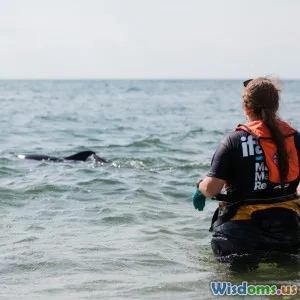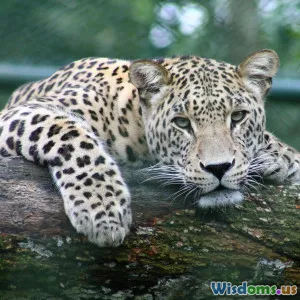
Can Wolves Teach Us Better Strategies For Teamwork
8 min read Discover how wolves' natural teamwork strategies can inspire human collaboration for improved efficiency and success. (0 Reviews)
Can Wolves Teach Us Better Strategies For Teamwork?
Introduction
Imagine walking through a dense forest at dawn and coming across a wolf pack on the hunt. The coordinated efforts, silent signals, and the intricate roles each wolf plays culminate in a unified success. Beyond their fierce image lies an advanced model of teamwork honed by evolution. Could humans, navigating complex corporate or social landscapes, learn a thing or two from these wild collaborators? This article delves deep into the wolf's world, exploring how their natural teamwork strategies offer profound insights for strengthening human cooperation.
The Wolf Pack: A Blueprint of Social Cooperation
Wolves live, hunt, and thrive in packs — social units defined by structure and mutual dependence. Unlike many other animals, wolves rely heavily on intuition-driven synchronized behavior rather than brute force alone.
Social Roles and Hierarchy
Every pack has an alpha pair — the leading male and female who guide decisions and social order. Yet, the alpha is not a tyrant but a leader based on experience, wisdom, and capability, maintaining balance rather than dominance. Other members, often called betas and omegas, have distinct roles contributing to pack harmony. This hierarchy fosters efficiency, helping the pack coordinate complex hunts and raise pups collectively.
Communication: The Silent Language of Success
Wolves use a nuanced mix of vocalizations, body language, and scent marking to communicate. From subtle tail tucks revealing submission to coordinated howls outlining territory or calling the group, their interaction transcends simple signaling. This sophisticated communication increases their ability to maneuver in high-pressure hunts, ensuring minimal wasted effort and maximum synergy.
Cooperative Hunting Tactics
Unlike solitary predators, wolves calculate strategies that rely on teamwork to subdue prey often larger than themselves, like elk or moose. They use splitting maneuvers—some wolves chase prey towards hidden pack members waiting in ambush. This division of labor enhances hunt success rates significantly. Hydrologists studying Yellowstone wolves observed up to 80% success rates during cooperative hunts, compared to lone wolf hunts which are considerably less efficient.
Lessons for Human Teamwork
Human teams face organizational challenges similar to wolf packs: diversity in talent, need for communication, and grabbing opportunities quickly. Let’s break down important takeaways from wolves' strategies.
Clear Structure Does Not Imply Authoritarianism
The alpha’s role is often misunderstood. In effective wolf packs, leadership is adaptive and consensual, avoiding petty conflicts. In the workplace, adopting a transparent yet flexible hierarchy can prevent power struggles while empowering appropriate decision-making. Leadership that resonates with earned respect rather than force boosts moral, reduces burnout, and streamlines goals.
Example:
Google’s management philosophy emphasizes servant leadership, akin to the alpha's role. Managers lead by supporting teams rather than commanding.
Effective Communication Fosters Cohesion
Wolves’ extensive communication repertoire teaches us the importance of clarity and multiple feedback channels. In organizations, encouraging open dialogue, reading non-verbal cues, and using diverse tools enhances understanding and preempts conflicts.
Research Insight:
Studies show teams with active communication see up to 50% improvement in project outcomes (Harvard Business Review, 2019).
Defined Roles with Flexibility
Every wolf has a function during hunts and pack life but can adapt as conditions demand. Similarly, human teams must define roles explicitly yet remain dynamic to tackle evolving challenges.
Real-world Scenario:
Agile project management imitates this principle, with shifting roles depending on phase and priorities, optimizing team adaptability.
Trust and Mutual Dependence
Wolves depend on mutual support — a misstep by a single member affects the entire pack's success. Building trust within teams improves risk-sharing, psychological safety, and conflict resolution.
Quote:
As management expert Stephen Covey famously stated, "Trust is the glue of life. It's the most essential ingredient in effective communication."
Applying Wolf Strategies in Different Contexts
Corporate Teams
Companies can harness wolf-style teamwork by cultivating trust cultures, defining clear leadership roles, and fostering continuous communication. Tech companies that mimic plucky, responsive leadership coupled with collaborative environments often outperform hierarchical giants.
Sports Teams
Athletic squads that emphasize coordinated plays, role clarity, and peer trust show statistically better performances. For instance, the Seattle Seahawks’ “Legion of Boom” defense thrived on structured roles and seamless communication analogous to a wolf pack hunting strategy.
Community and Social Movements
Community organizers can integrate these principles to unify diverse stakeholders toward common goals, using shared leadership models and explicit role assignments to balance contributions and responsibilities.
Challenges and Considerations
While wolves offer remarkable lessons, direct translations to human contexts demand caution. Humans possess complex emotions, cultural diversity, and individual aspirations that differ significantly from animal instincts. Flexibility and empathy remain crucial to avoid rigid or overly simplistic applications.
Conclusion
Wolves do not just survive in the wild; they thrive because of their intrinsic teamwork wisdom. Their strategies — leadership by respect, rich communication, defined yet adaptable roles, and deep trust — provide a compelling model for any human group striving to collaborate better. By looking beyond the surface and embracing these natural frameworks, organizations, teams, and communities can sharpen their strategies, improve outcomes, and foster sustainable relationships. Next time you think about teamwork, picture the wolf pack, and perhaps you’ll find answers hidden in the howls beneath the moonlight.
References:
- Mech, L. D. "The Wolf: The Ecology and Behavior of an Endangered Species." University of Minnesota Press, 1970.
- Smith, D., et al. "Cooperation and Hunting Success in Wolf Packs." Journal of Animal Ecology, 2018.
- Harvard Business Review. "Communication in Teams: A Key to Success," 2019.
- Covey, S. R. "The 7 Habits of Highly Effective People." Free Press, 1989.
- Case study: Seattle Seahawks defense, NFL, 2013-2018 seasons.
Rate the Post
User Reviews
Other posts in Primates & Mammals
Popular Posts















